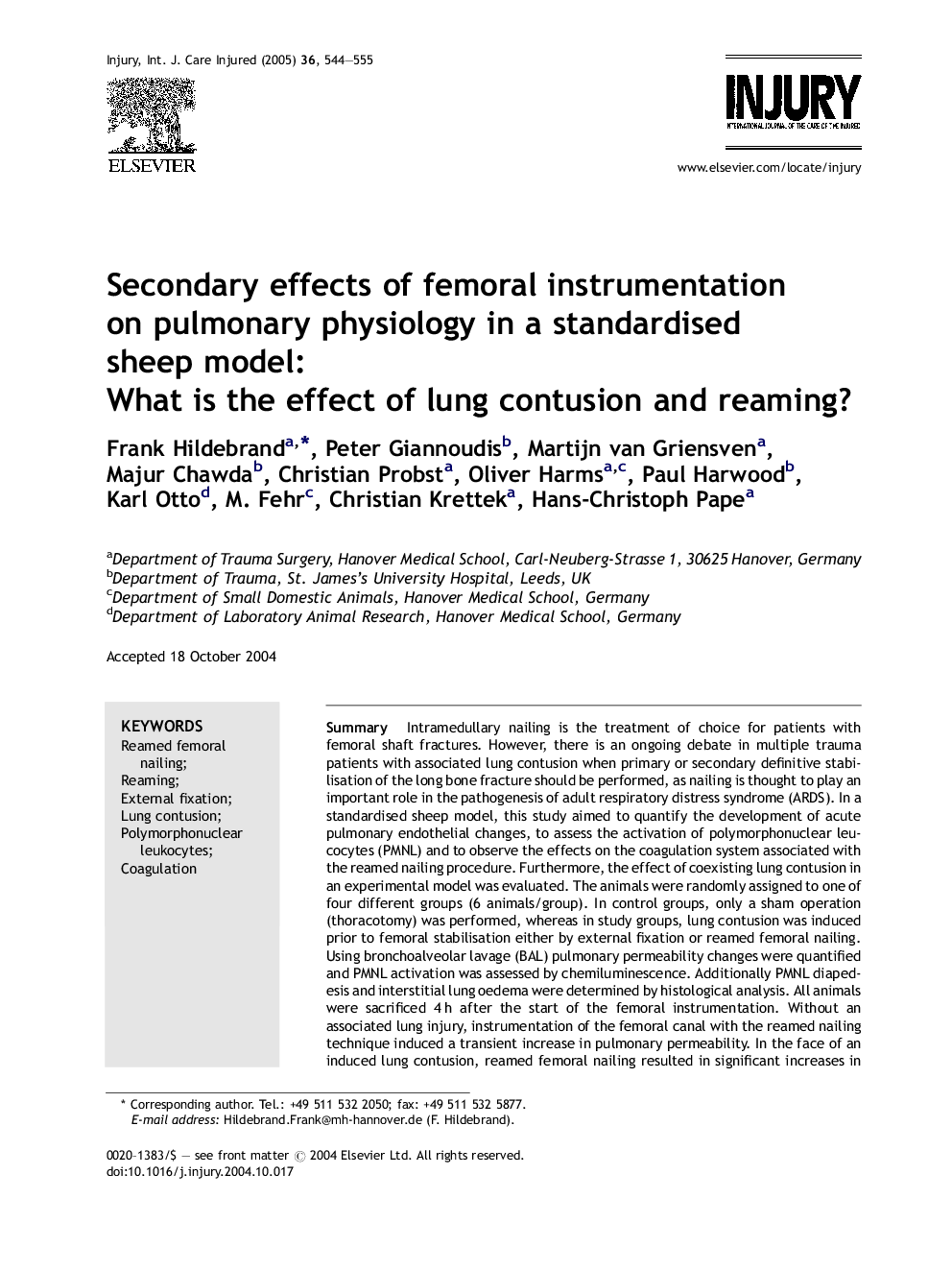| کد مقاله | کد نشریه | سال انتشار | مقاله انگلیسی | نسخه تمام متن |
|---|---|---|---|---|
| 9234193 | 1206145 | 2005 | 12 صفحه PDF | دانلود رایگان |
عنوان انگلیسی مقاله ISI
Secondary effects of femoral instrumentation on pulmonary physiology in a standardised sheep model:
دانلود مقاله + سفارش ترجمه
دانلود مقاله ISI انگلیسی
رایگان برای ایرانیان
کلمات کلیدی
موضوعات مرتبط
علوم پزشکی و سلامت
پزشکی و دندانپزشکی
طب اورژانس
پیش نمایش صفحه اول مقاله

چکیده انگلیسی
Intramedullary nailing is the treatment of choice for patients with femoral shaft fractures. However, there is an ongoing debate in multiple trauma patients with associated lung contusion when primary or secondary definitive stabilisation of the long bone fracture should be performed, as nailing is thought to play an important role in the pathogenesis of adult respiratory distress syndrome (ARDS). In a standardised sheep model, this study aimed to quantify the development of acute pulmonary endothelial changes, to assess the activation of polymorphonuclear leucocytes (PMNL) and to observe the effects on the coagulation system associated with the reamed nailing procedure. Furthermore, the effect of coexisting lung contusion in an experimental model was evaluated. The animals were randomly assigned to one of four different groups (6 animals/group). In control groups, only a sham operation (thoracotomy) was performed, whereas in study groups, lung contusion was induced prior to femoral stabilisation either by external fixation or reamed femoral nailing. Using bronchoalveolar lavage (BAL) pulmonary permeability changes were quantified and PMNL activation was assessed by chemiluminescence. Additionally PMNL diapedesis and interstitial lung oedema were determined by histological analysis. All animals were sacrificed 4Â h after the start of the femoral instrumentation. Without an associated lung injury, instrumentation of the femoral canal with the reamed nailing technique induced a transient increase in pulmonary permeability. In the face of an induced lung contusion, reamed femoral nailing resulted in significant increases in PMNL activation, pulmonary permeability and interstitial lung oedema, compared with external fixation. Without pulmonary contusion, reaming of the femoral canal was associated with a transient increase in pulmonary permeability. This was exacerbated in the presence of lung contusion along with increased PMNL activation. External fixation did not provoke similar changes. The findings of this study support the view that reaming of the femoral canal should be avoided in polytrauma patients with severe chest trauma as it could act as an additional stimulus for adverse outcome. Temporary external fixation appears to be a safe method for fracture stabilisation until inflammatory and coagulatory disturbances after trauma have been normalized.
ناشر
Database: Elsevier - ScienceDirect (ساینس دایرکت)
Journal: Injury - Volume 36, Issue 4, April 2005, Pages 544-555
Journal: Injury - Volume 36, Issue 4, April 2005, Pages 544-555
نویسندگان
Frank Hildebrand, Peter Giannoudis, Martijn van Griensven, Majur Chawda, Christian Probst, Oliver Harms, Paul Harwood, Karl Otto, M. Fehr, Christian Krettek, Hans-Christoph Pape,